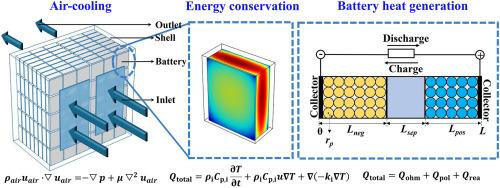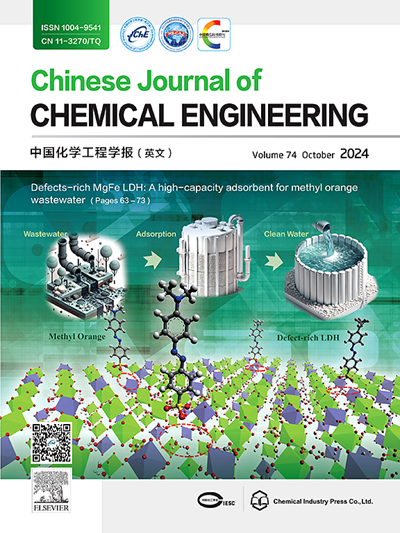集成电化学和热模型改进锂离子电池储能系统散热
IF 3.7
3区 工程技术
Q2 ENGINEERING, CHEMICAL
引用次数: 0
摘要
锂离子电池具有能量密度高、无记忆效应、自放电率低、循环寿命长等优点,在电化学电池储能系统中得到了广泛应用。但如果电池在放电过程中散热不充分,会严重影响电池的性能。BESS效率的提高取决于热管理结构的优化。在这项工作中,我们将伪二维(P2D)电化学模型与三维热模型相结合,分析了BESS内部的热量产生和传递过程。在电压和温升曲线方面,仿真结果与实验结果非常吻合。在293.15 K、3 m·s−1的风冷条件下,BESS最高温度为308.60 K,温差为9.22 K,可保证安全运行。在1℃时,我们建议加大进、出口面积提高风冷效率,并在排出2400 s后过渡环境风冷温度,有效降低了冷却设备的温差和能耗。这项工作为优化BESS的热设计提供了有价值的理论见解。本文章由计算机程序翻译,如有差异,请以英文原文为准。

Integrating electrochemical and thermal models for improved lithium-lon battery energy storage system heat dissipation
Lithium-ion batteries (LIBs) are widely used in electrochemical battery energy storage systems (BESS) because of their high energy density, lack of memory effects, low self-discharge rate, and long cycle life. However, inadequate heat dissipation during their discharge process can significantly degrade battery performance. The improvement of BESS efficiency depends on the optimization of thermal management structures. In this work, we integrate the pseudo-two-dimensional (P2D) electrochemical model with a three-dimensional thermal model to analyze the heat generation and transfer processes within the BESS. The simulation results are closely aligned with the experimental results in terms of voltage and temperature rise curves. Under air cooling conditions of 293.15 K and 3 m·s−1, the BESS has a maximum temperature of 308.60 K and a temperature difference of 9.22 K, ensuring safe operation. At 1 C, we suggest that enlarging the inlet and outlet areas improves the air-cooling efficiency, and transitioning environmental air-cooling temperatures after 2400 s of discharge effectively reduces the temperature difference and the energy consumption of the cooling equipment. This work provides valuable theoretical insights for optimizing the thermal design of BESS.
求助全文
通过发布文献求助,成功后即可免费获取论文全文。
去求助
来源期刊

Chinese Journal of Chemical Engineering
工程技术-工程:化工
CiteScore
6.60
自引率
5.30%
发文量
4309
审稿时长
31 days
期刊介绍:
The Chinese Journal of Chemical Engineering (Monthly, started in 1982) is the official journal of the Chemical Industry and Engineering Society of China and published by the Chemical Industry Press Co. Ltd. The aim of the journal is to develop the international exchange of scientific and technical information in the field of chemical engineering. It publishes original research papers that cover the major advancements and achievements in chemical engineering in China as well as some articles from overseas contributors.
The topics of journal include chemical engineering, chemical technology, biochemical engineering, energy and environmental engineering and other relevant fields. Papers are published on the basis of their relevance to theoretical research, practical application or potential uses in the industry as Research Papers, Communications, Reviews and Perspectives. Prominent domestic and overseas chemical experts and scholars have been invited to form an International Advisory Board and the Editorial Committee. It enjoys recognition among Chinese academia and industry as a reliable source of information of what is going on in chemical engineering research, both domestic and abroad.
 求助内容:
求助内容: 应助结果提醒方式:
应助结果提醒方式:


